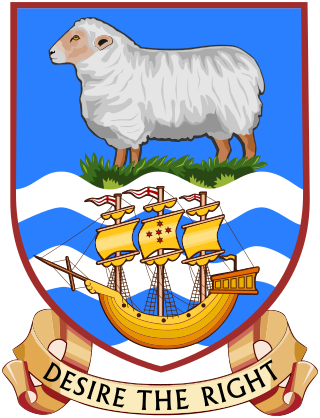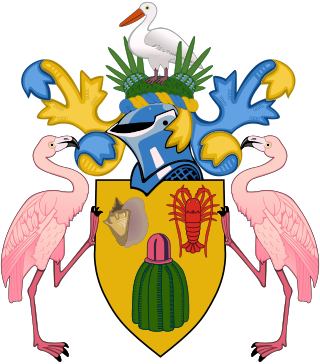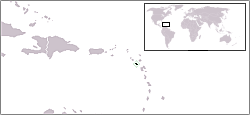
Montserrat is a British Overseas Territory in the Caribbean. It is part of the Leeward Islands, the northern portion of the Lesser Antilles chain of the West Indies. Montserrat is about 16 km (10 mi) long and 11 km (7 mi) wide, with roughly 40 km (25 mi) of coastline. It is nicknamed "The Emerald Isle of the Caribbean" both for its resemblance to coastal Ireland and for the Irish ancestry of many of its inhabitants. Montserrat is the only non-fully sovereign full member of the Caribbean Community and the Organisation of Eastern Caribbean States.

The British West Indies (BWI) were colonised British territories in the West Indies: Anguilla, the Cayman Islands, Turks and Caicos Islands, Montserrat, the British Virgin Islands, Antigua and Barbuda, The Bahamas, Barbados, Dominica, Grenada, Jamaica, Saint Kitts and Nevis, Saint Lucia, Saint Vincent and the Grenadines, British Guiana and Trinidad and Tobago. Other territories included Bermuda, and the former British Honduras.

The coat of arms of Anguilla is the heraldic device consisting of a shield charged with three orange dolphins leaping over the sea. Adopted in 1990, it has been the coat of arms of Anguilla since that year. The escutcheon is featured on the flag of the territory.

The flag of Montserrat consists of a Blue Ensign defaced with the British overseas territory's coat of arms. Adopted in 1960 to supplement the Union Jack after the dissolution of the British Leeward Islands the year before, it has been the flag of Montserrat since the territory was granted self-government that year. The design of the present flag entailed enlarging the coat of arms and outlining it with a white trim. Montserrat's flag is similar to the flags of eight other British Overseas Territories, which are also Blue Ensigns with their respective coats of arms.

The flag of Saint Helena consists of a Blue Ensign defaced with the shield from the British overseas territory's coat of arms. Adopted in 1984 shortly after the island was granted a new coat of arms, it has been the flag since. Saint Helena's flag is similar to the flags of eight other British Overseas Territories, which are also Blue Ensigns with their respective coats of arms.

The flag of Saint Lucia consists of a cerulean blue field charged with a golden triangle in front of a white-edged black isosceles triangle. Adopted in 1967 to replace the British Blue Ensign defaced with the arms of the colony, it has been the flag of Saint Lucia since the country became an associated state of the United Kingdom that year. Although the overall design of the flag has remained unchanged, specific aspects of it have been altered over the years.

The flag of the British Virgin Islands was adopted by Royal Warrant on 15 November 1960 after the islands were made into a separate British colony. Previously, the territory was administered as part of the British Leeward Islands.

The flag of the Cayman Islands consists of a Blue Ensign defaced with the British overseas territory's coat of arms. Adopted in 1959 to supplement the Union Jack and to replace the flag of the Colony of Jamaica, it has been the flag of the Cayman Islands since the territory was granted self-government that year. The design of the present flag entailed removing the white disc and outlining the coat of arms with a white trim, although the previous version is often used in an official capacity. The Cayman Islands' flag is similar to the flags of eight other British Overseas Territories, which are also Blue Ensigns with their respective coats of arms.

The coat of arms of the Falkland Islands is the heraldic device consisting of a shield charged with a ram on tussock grass in a blue field at the top and a sailing ship on white and blue wavy lines underneath. Adopted in 1948, it has been the coat of arms of the Falkland Islands since 29 September of that year, except for the two-month occupation of the territory during the Falklands War in 1982. The escutcheon is featured on the flag of the territory. The ram represents the territory's past primary industry of sheep farming, while the ship symbolises the Desire which reportedly first sighted the islands at the end of the 16th century. The grass indicates the vegetation of the Falklands.

The coat of arms of Fiji is the heraldic device consisting of a shield divided quarterly by Cross of St. George and charged with a gold lion at the top, supported by two Fijian warriors, one on each side, and topped with a canoe as the crest. Adopted in 1908 by a Royal Warrant, it has been the coat of arms of Fiji since that year, having been retained after independence in 1970. The escutcheon from the arms is featured on the flag of Fiji.

The coat of arms of the British Virgin Islands consists of a green escutcheon (shield) charged with a woman in a white dress and gold-coloured sandals, holding a lit golden oil lamp and surrounded by eleven other golden lamps. Adopted shortly after the islands became a Crown colony, it has been the coat of arms of the British Virgin Islands since 1960. The escutcheon dates from the early 19th century and is featured on the flag of the territory. The woman and the lamps represent Saint Ursula and her companions, the namesake of the islands.

The coat of arms of the Turks and Caicos Islands consists of a gold-coloured escutcheon (shield) charged with a conch shell, lobster and a cactus, supported by two flamingos, and topped with a pelican in the crest. Adopted three years after the islands became a Crown colony, it has been the coat of arms of the Turks and Caicos Islands since 1965. The escutcheon is featured on the flag of the territory. The previous badge featured two mounds of salt in front of a ship, with doors added to the mounds after they were reportedly mistaken for igloos.
Montserrat, a British Overseas Territory located in the Caribbean, played a minor role in the First World War. Much of their contribution was funding or materials gathered by civilians, although a small number of Montserratians served in the Army, or Marine Navy. Montserrat holds a Remembrance Day annually on 14 November, to remember Montserratians who died in World War I, alongside those who died in World War II and the Iraq War.

The coat of arms of Jersey is the heraldic device consisting of a shield charged with three gold lions on a red field. Utilised unofficially before the 20th century, its status as the coat of arms of the Bailiwick of Jersey was formalized in 1907. The escutcheon is featured on the flag of the dependency.

The flag of Sint Maarten consists of a white triangle situated at the hoist charged with the constituent country's coat of arms, along with two horizontal bands of red and blue. Adopted in 1985 shortly after the territory was granted a coat of arms, it has been the flag of Sint Maarten since 13 June of that year. Since the dissolution of the Netherlands Antilles on 10 October 2010, it has been the sole flag used in the constituent country.

The coat of arms of Senegal is the heraldic device consisting of a shield charged with a lion on the left half and a baobab tree on the right, flanked by palm branches and topped with a five-pointed green star at the top.

The flag of the British Leeward Islands was the flag of the Federal Colony of the Leeward Islands. It was a Blue Ensign with a badge. The colonies under the Federal Colony had their own badges from 1909. The Governor-in-chief of the Leeward Islands used a Union Flag defaced with the coat of arms.

The badge of the British Leeward Islands was adopted in the 1870s.

The following outline is provided as an overview of and topical guide to Montserrat:

The following is an alphabetical list of topics related to the British Overseas Territory of Montserrat.




















